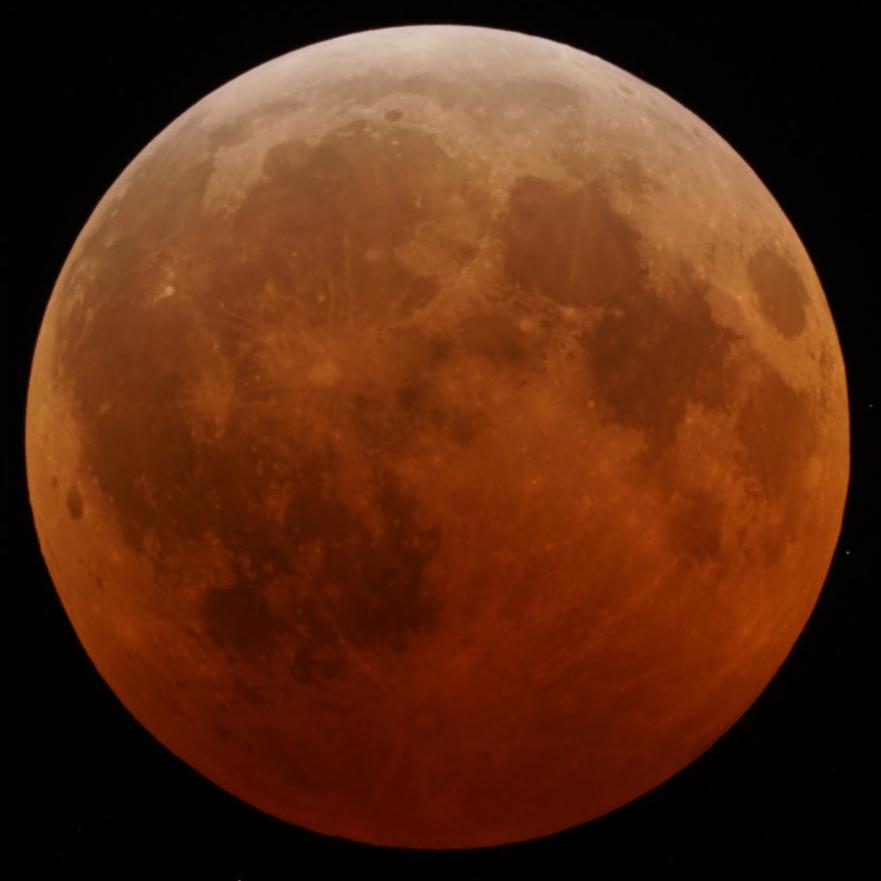 |
| The total lunar eclipse on Dec. 11, 2010 as seen from California. |
Last month, there was a very special lunar eclipse. It occurred on Dec. 21, the winter solstice. It is special because in the last 2000 years, only one other lunar eclipse has fallen on a winter solstice.
Sadly, it took place in the middle of a very messy December and was clouded out. But, to be ready for the next eclipse, let's find out what an eclipse actually is.
From Earth, two different types of eclipses involving the Moon can be seen. The first kind, a lunar eclipse, happens when the Moon is hidden in the Earth's shadow. If you were on the Moon, you would see the Sun getting blocked out by the disc of the Earth.
A small amount of light is bent by Earth's atmosphere and projected on to the Moon. Depending on atmospheric conditions, the Moon can appear a deep blood red, brown, or dark grey. During years with volcanic activity the Moon can appear quite dim since less light makes it through the dusty upper atmosphere.
In some eclipses, the Moon isn't in the darkest part of the Earth's shadow. These are called partial lunar eclipses. Part of the Moon may appear to dim and can even look like someone took a bite out of the Moon!
The other type of eclipse involving the Moon is the solar eclipse. Total solar eclipses are much more dramatic because they take place in a matter of minutes instead of over a few hours.
During a solar eclipse, the Moon is between the Earth and the Sun. The Moon may cover only part of the Sun resulting in a partial eclipse. The Moon could also be too far from Earth (depending on the time of year) and not be large enough to cover the entire disc of the Sun, lead to a beautifully bright ring, called an annular eclipse.
When the Moon is close enough to Earth, it can just barely block the entire Sun, and if you're at the right place at the right time, you're in for quite a show.
 |
| A total solar eclipse in 1999. |
The Moon will slowly cover up the Sun, but this doesn't actually dim the light from the Sun very much. As the Moon is covering up the last bit of the Sun, the final bit of sunlight will be shining in between lunar hills, causing what is known as Baily's beads.
During the last few seconds, everything around you will go completely dark, and stars show up in the sky. Some animals may behave oddly thinking its nighttime. This time is called totality. It may be very brief, but can last up to seven minutes, if you're lucky.
Since the bright surface of the Sun will be blocked, you would be able to see the Sun's outer atmosphere glowing around it. You might even see a solar flare!
But, if you happen to be lucky enough to be watching a solar eclipse, be careful. The Sun's light can severely damage your eyesight, especially after totality when your eyes will be used to the dark. The majority of the eclipse is best viewed through welding glasses, or through a telescope with a solar filter firmly attached to the front of the telescope.
The next total solar eclipse visible in Summerside, PEI, is on August 8, 2024, but solar eclipses happen a couple of times a year, visible only in a small area somewhere around the globe. Lunar eclipses are just as common, but can be easily seen from anywhere on the planet.
Until then, let's take a look at this month's sky.
The Quadrantid meteor show will peak on the night of Jan. 3, so keep an eye out for "shooting stars".
The full Moon will be on Jan. 4, while the new Moon will be on Jan. 19.
Jupiter will be shining brightly in the south-west shortly after sunset throughout the month.
The Athena Community Astronomy Club will be holding its monthly meeting on Sunday, Jan. 30, at the Wilmot Community Centre. The meeting runs from 7pm to 9pm. Guests are always welcome.
Until next month, just look up!
Hey Kids...
Remember those little robotic rovers, Spirit and Opportunity, driving around on Mars? They are still there and seem to be working fine. Spirit is stuck in some sand and is hibernating for the winter, waiting for Martian spring. Opportunity, in a warmer location, keeps on truckin'. Right now, Opportunity is taking a look at a big hole in the ground, caused by an asteroid smashing into Mars many years ago. This crater is the size of a football field! Maybe it will discover something that will help keep us safe from asteroids. You can never know with science what useful nuggets of information you may find, unless you go out and look!